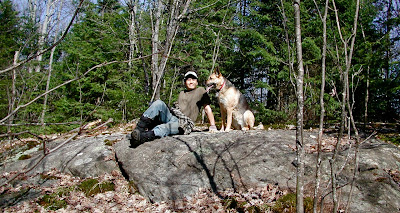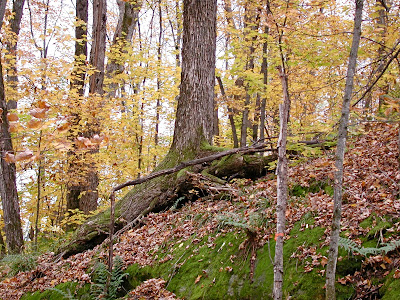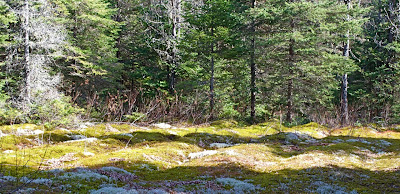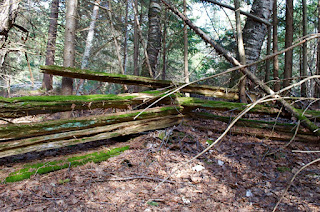In my last post, we read the signs of
animal activity in the forest. It amazes me every time to see how much is going on every day in our own patch of woods. But there's more than just current animal tales to see. If we know what to look for, we can peek into the past and see how the land was shaped by settlers over a hundred years ago and by the forces of nature over millennia.
 |
| Ancient bedrock. Somewhat-less-ancient Jim and Saba. |
If we start at the beginning of the narrative, we'll have to go back a few billion years to the Precambrian era which is when the Canadian Shield formed. The exposed bedrock you see as you travel through the region is some of the oldest in the world. Though the elevation is quite low now, these rocks are the roots of ancient mountains, eroded over time and rising up (like an iceberg) above the mantle below.
 |
| If this wall could talk... |
Glaciers advancing and receding over Canada over twelve thousand years ago also left marks we can still see during a walk in the woods today. The ice sheets of the glacial period picked up and transported rocks and debris as they moved, scraping away soil and scouring lake basins. Every time I see a lonely bolder sitting amid a stand of trees I wonder if it was dropped there by a glacier "back in the day".
 |
| Was this boulder left behind by a glacier? |
It can be easy to assume, when I'm surrounded by tall, strong trees, that the soil here is rich and deep. But then, after a windstorm perhaps, I'll see a healthy tree has come down with it's root system still attached. And I'll see the roots have only been growing in a mere foot and a half of soil which was lifted--intact--off solid rock as the tree fell.
 |
| You can see solid, bare rock on the other side of those roots. |
You can see the sparseness of the soil over bedrock (and the stubborn determination of these trees to grow in it anyway) when you see a tree with it's roots spread out over the ground instead of reaching deep down into it.
 |
| Big, beautiful tree is holding on to a thin layer of soil over rock. |
 |
| Saba walking on a furrow. |
Turning the pages of the history book forward, the signs of recent history are easier to see and decipher. This land was settled as part of the Land Grants program in the 1880's. One of the conditions of the deal was that settlers had to clear 40 acres for farming (which would
not have been an easy task). We can still see the furrows, now covered in moss, very clearly on our Mossy Trail.
 |
| You can still see the furrow (now covered in moss) from the farm days. |
Throughout the property are piles of fieldstones. Every stone in every pile would have been lifted by hand and piled up out of the way of the field work. Very likely it was a job for the children to do.
 |
| One of many piles of fieldstone throughout the property. |
 |
| Nicely intact section of fence, perhaps 100 years old. |
In one spot just off the Mossy Trail, you can see the remains of a split rail fence covered in a lovely, vibrant moss. Was this to keep cows in? To mark a border? How long was it and who built it? We don't know and probably will never find out.
There are many narratives only hinted at throughout the forest--of current activity as well as the recent and distant past. Take a walk, keep your eyes open, and enjoy the mystery as much as the answers.







 Discover the stories of the wildlife in our woods in Reading the Forest - Animal Tales.
Discover the stories of the wildlife in our woods in Reading the Forest - Animal Tales.


No comments:
Post a Comment